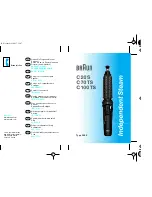
sure that the surface is heat resistant and
waterproof. Do not use glass and plastic
surface.
BEORE FIRST USAGE
•
Take out the iron from the package and
remove the protective cartoon covering
from the iron sole
(1).
• Wipe the sole with a soft cloth
.
• Before plugging in, set the power switch
(10) according to the voltage of the mains.
After using of the unit at 110-120V always
set the switch (10) to the 220-240V posi-
tion, it will prevent the iron from malfunc-
tion in case of sudden plugging in of the
unit into the mains with insufficient volt-
age.
Filling with water (pic. 1)
- Before using the unit, fill the tank with tap-
ping water, if tapping water is too hard, it
is recommended using of distilled water.
-
Before filling the unit with water, make
sure that it is unplugged.
• Set the steam supply regulator (6) to the
position of steam OFF
.
• Open the water tank lid (4).
• Use the water tank (12), fill the tank with
not more than 40 ml of water and close
the lid (4).
Note:
Steam will not be supplied if there is no
water in the tank.
• If you want to add water during iron-
ing, unplug the unit.
• Do not fill the water tank with scent-
ed liquids, vinegar, starch solution,
descaling reagents, chemical agents
etc.
•
After you finish ironing, switch off the
iron, let it cool down completely, then
open the water tank lid (4), turn round
the iron and drain the remaining water
(pic.6).
IRONING TEMPERATURE
Before operating test the heated iron on the
old cloth to be sure that the iron sole (1) and
the water tank are clean.
•
Always check the recommended iron
temperature indicated on the tag before
ironing.
• If the tag does not list the recommended
ironing temperature, but you know the
type of fabric, then use the following table
to determine the proper temperature.
Signs
Fabric type/temperature
•
Synthetics, nylon, acryl, polyester
(low temperature)
••
Silk/wool (medium temperature)
•••
Cotton/flax (high temperature)
•
This table is only for smooth materials.
Fabrics of other types (crimped, raised
etc.) are best ironed at low temperature.
•
The iron heats up faster than is cools
down. For this reason it is recommended
to begin ironing at low temperature (for in-
stance synthetic fabrics). After that, move
to higher temperature ironing. Cotton and
linens should be ironed last.
•
If an item is made from a mix of fabrics,
then the iron should be set for the fab-
ric with the lowest ironing (for instance if
an item is made from 60% polyester and
40% cotton, it should be ironed at the
temperature used for ironing polyester
“
•
”).
•
If you cannot define the fabric the item is
made from, find a place on it that is hid-
den while wearing and, on practice select
the ironing temperature (always start at
the lowest and gradually raise it until you
get the desired result.)
•
Corduroy and other fabrics that start
glossy quickly should be ironed strictly in
one direction (along the lines) with slight
pressure.
• To avoid appearance of glossy spots on
the synthetic and silk fabrics, iron them
back-side.
5
ENGLISH
1254.indd 5
1254.indd 5
29.01.2009 14:26:20
29.01.2009 14:26:20
Содержание VT-1254
Страница 1: ...1254 indd 1 1254 indd 1 29 01 2009 14 26 18 29 01 2009 14 26 18...
Страница 2: ...2 1254 indd 2 1254 indd 2 29 01 2009 14 26 20 29 01 2009 14 26 20...
Страница 3: ...3 1254 indd 3 1254 indd 3 29 01 2009 14 26 20 29 01 2009 14 26 20...
Страница 15: ...15 60 40 5 8 2 7 1 7 5 8 2 7 1 7 8 MIN 1254 indd 15 1254 indd 15 29 01 2009 14 26 20 29 01 2009 14 26 20...
Страница 19: ...19 1 10 110 120 10 220 240 1 6 4 12 40 4 6 1 1254 indd 19 1254 indd 19 29 01 2009 14 26 21 29 01 2009 14 26 21...
Страница 33: ...33 1 10 110 120 10 220 240 1 6 4 12 40 4 4 6 1254 indd 33 1254 indd 33 29 01 2009 14 26 21 29 01 2009 14 26 21...
Страница 34: ...34 1 60 40 5 8 2 7 1 7 5 8 1254 indd 34 1254 indd 34 29 01 2009 14 26 21 29 01 2009 14 26 21...
Страница 39: ...39 I 60 40 5 8 2 7 1 7 5 8 2 7 1 7 1254 indd 39 1254 indd 39 29 01 2009 14 26 22 29 01 2009 14 26 22...
Страница 48: ...1254 indd 48 1254 indd 48 29 01 2009 14 26 22 29 01 2009 14 26 22...






































